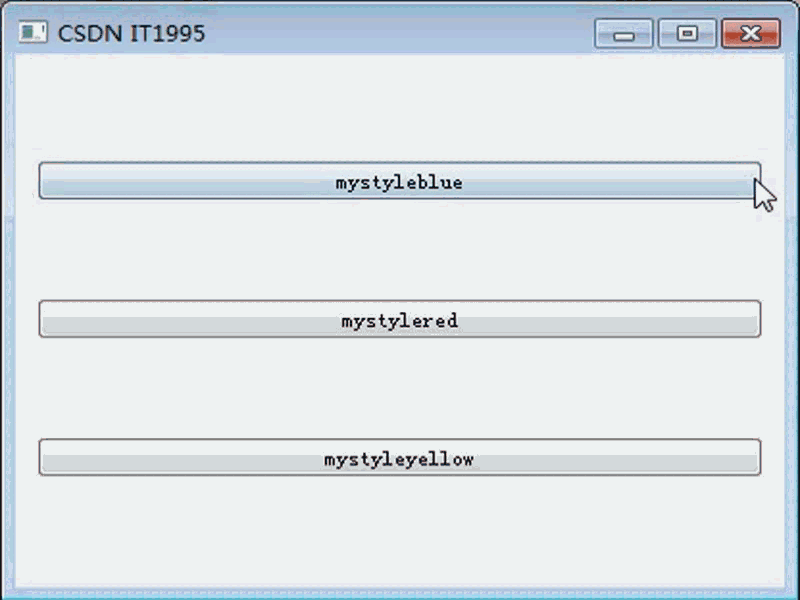版权声明:本文为博主原创文章,未经博主允许不得转载。 https://blog.csdn.net/qq78442761/article/details/86602436
目录
关键
插件端:
Q_PLUGIN_METADATA(IID "org.qt-project.Qt.QStyleFactoryInterface" FILE "mystyle.json")在QStylePlugin中这个是必须的:org.qt-project.Qt.QStyleFactoryInterface"
json文件中的数据,最好与
QStyle *MyStylePlugin::create(const QString &key)
{
if (key.toLower() == "mystyleyellow")
return new MyStyle;
return 0;
}这个一样!
插件读取端:
QStylePlugin中可以使用QStyleFactory调用插件!
QStyleFactory::keys();可以获取key值,QStyleFactory::create()这个可以创建!
注意要放到这个文件中:

styles文件如下:

演示及源码
程序运行截图如下:

插件端:

mystyle.h
#ifndef SIMPLESTYLE_H
#define SIMPLESTYLE_H
#include <QProxyStyle>
QT_BEGIN_NAMESPACE
class QPalette;
QT_END_NAMESPACE
class MyStyle : public QProxyStyle
{
Q_OBJECT
public:
MyStyle() {}
void polish(QPalette &palette) override;
};
#endif
mystyleplugin.h
#ifndef SIMPLESTYLEPLUGIN_H
#define SIMPLESTYLEPLUGIN_H
#include <QStylePlugin>
QT_BEGIN_NAMESPACE
class QStringList;
class QStyle;
QT_END_NAMESPACE
class MyStylePlugin : public QStylePlugin
{
Q_OBJECT
Q_PLUGIN_METADATA(IID "org.qt-project.Qt.QStyleFactoryInterface" FILE "mystyle.json")
public:
MyStylePlugin() {}
QStringList keys() const;
QStyle *create(const QString &key) override;
};
#endifmystyle.cpp
#include "mystyle.h"
#include "mystyleplugin.h"
#include <QtWidgets>
void MyStyle::polish(QPalette &palette)
{
palette.setBrush(QPalette::Window, Qt::yellow);
}
mystyleplugin.cpp
#include "mystyleplugin.h"
#include "mystyle.h"
#include <QtWidgets>
QStringList MyStylePlugin::keys() const
{
return QStringList() << "MyStyleYellow";
}
QStyle *MyStylePlugin::create(const QString &key)
{
if (key.toLower() == "mystyleyellow")
return new MyStyle;
return 0;
}
StylePluginDemo.pro
TEMPLATE = lib
CONFIG += plugin
QT += widgets
TARGET = StylePluginYellow
SOURCES += \
mystyle.cpp \
mystyleplugin.cpp
HEADERS += \
mystyle.h \
mystyleplugin.h
EXAMPLE_FILES += mystyle.json
win32 {
CONFIG(debug, release|debug):DESTDIR = debug/styles/
CONFIG(release, release|debug):DESTDIR = release/styles/
} else {
DESTDIR = ../styles/
}
EXAMPLE_FILES += simplestyle.json
json文件如下:
{
"Keys": ["mystyleyellow"]
}插件读取端:

widget.h
#ifndef WIDGET_H
#define WIDGET_H
#include <QWidget>
namespace Ui {
class Widget;
}
class Widget : public QWidget
{
Q_OBJECT
public:
explicit Widget(QWidget *parent = 0);
~Widget();
protected slots:
void btnClicked();
private:
Ui::Widget *ui;
};
#endif // WIDGET_Hmain.cpp
#include "widget.h"
#include <QApplication>
int main(int argc, char *argv[])
{
QApplication a(argc, argv);
Widget w;
w.show();
return a.exec();
}
widget.cpp
#include "widget.h"
#include "ui_widget.h"
#include <QDebug>
#include <QStyleFactory>
#include <QStyle>
#include <QVBoxLayout>
#include <QPushButton>
Widget::Widget(QWidget *parent) :
QWidget(parent),
ui(new Ui::Widget)
{
ui->setupUi(this);
this->setWindowTitle("CSDN IT1995");
QStringList list = QStyleFactory::keys();
qDebug() << list;
QVBoxLayout *layout = new QVBoxLayout;
for(int i = 0; i < list.size(); i++){
if(list[i].contains("mystyle")){
QPushButton *btn = new QPushButton(list[i]);
layout->addWidget(btn);
connect(btn, SIGNAL(clicked(bool)), this, SLOT(btnClicked()));
}
}
setLayout(layout);
}
Widget::~Widget()
{
delete ui;
}
void Widget::btnClicked()
{
QString text = static_cast<QPushButton*>(sender())->text();
QStyle *style = QStyleFactory::create(text);
QApplication::setStyle(style);
}